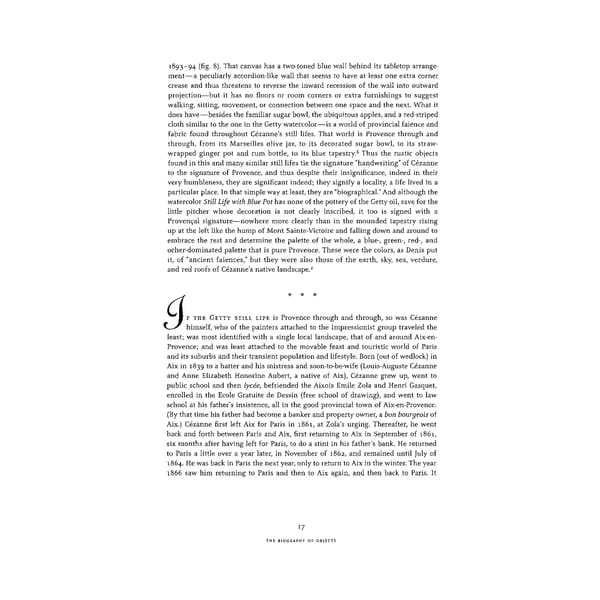1893~94 (fig- 8). That canvas has a two-toned blue wall behind its tabletop arrange- ment—a peculiarly accordion-like wall that seems to have at least one extra corner crease and thus threatens to reverse the inward recession of the wall into outward projection—but it has no floors or room corners or extra furnishings to suggest walking, sitting, movement, or connection between one space and the next. What it does have—besides the familiar sugar bowl, the ubiquitous apples, and a red-striped cloth similar to the one in the Getty watercolor—is a world of provincial faience and fabric found throughout Cezanne's still lifes. That world is Provence through and through, from its Marseilles olive jar, to its decorated sugar bowl, to its straw- wrapped ginger pot and rum bottle, to its blue tapestry.5 Thus the rustic objects found in this and many similar still lifes tie the signature "handwriting" of Cezanne to the signature of Provence, and thus despite their insignificance, indeed in their very humbleness, they are significant indeed; they signify a locality, a life lived in a particular place. In that simple way at least, they are "biographical." And although the watercolor Still Life with Blue Pot has none of the pottery of the Getty oil, save for the little pitcher whose decoration is not clearly inscribed, it too is signed with a Provencal signature—nowhere more clearly than in the mounded tapestry rising up at the left like the hump of Mont Sainte-Victoire and falling down and around to embrace the rest and determine the palette of the whole, a blue-, green-, red-, and ocher-dominated palette that is pure Provence. These were the colors, as Denis put it, of "ancient faiences," but they were also those of the earth, sky, sea, verdure, and red roofs of Cezanne's native landscape.6 IF THE GETTY STILL LIFE is Provence through and through, so was Cezanne himself, who of the painters attached to the Impressionist group traveled the least; was most identified with a single local landscape, that of and around Aix-en- Provence; and was least attached to the movable feast and touristic world of Paris and its suburbs and their transient population and lifestyle. Born (out of wedlock) in Aix in 1839 to a hatter and his mistress and soon-to-be-wife (Louis-Auguste Cezanne and Anne Elizabeth Honorine Aubert, a native of Aix), Cezanne grew up, went to public school and then lycee, befriended the Aixois Emile Zola and Henri Gasquet, enrolled in the Ecole Gratuite de Dessin (free school of drawing), and went to law school at his father's insistence, all in the good provincial town of Aix-en-Provence. (By that time his father had become a banker and property owner, a bon bourgeois of Aix.) Cezanne first left Aix for Paris in 1861, at Zola's urging. Thereafter, he went back and forth between Paris and Aix, first returning to Aix in September of 1861, six months after having left for Paris, to do a stint in his father's bank. He returned to Paris a little over a year later, in November of 1862, and remained until July of 1864. He was back in Paris the next year, only to return to Aix in the winter. The year 1866 saw him returning to Paris and then to Aix again, and then back to Paris. It 17 THE BIOGRAPHY OF OBJECTS
 Cézanne in the Studio: Still Life in Watercolors Page 31 Page 33
Cézanne in the Studio: Still Life in Watercolors Page 31 Page 33